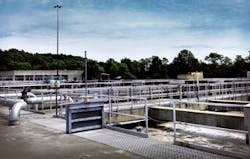The Value of Efficiency
The Hill Canyon Wastewater Treatment Plant (HCTP) for the city of Thousand Oaks, Calif., treats up to 11 million gal per day on average. The treatment includes screening, grit removal, clarification, nutrient removal, secondary clarification, multimedia filtration, disinfection and dechlorination before the treated water is discharged for reclamation.
The original plant was built in 1961, but has undergone several upgrades since then to accept additional flow, improve operational economy efficiency, and increase conservation while meeting environmental and renewable energy concerns. As with most wastewater treatment facilities, a significant part of the process includes capturing the biogas from the digesters and converting it to electrical power used at the site. This cogeneration of electricity has become an important process in wastewater treatment, replacing an otherwise large amount of electricity that would have to be purchased from a local utility. Up to 60% of the power consumed at the site is used to operate the blower units that create the dissolved oxygen in the aeration basin.
Aeration Infrastructure
The plant has six aeration basins—four newer deep basins that were built and placed into operation in 2003 and two older shallow basins that were retrofitted during the same time. To provide the required dissolved oxygen flow for all six basins, the plant has installed six constant-speed Turblex blowers with variable inlet and discharge vanes. The six blowers are divided into two sets. Each blower set has one lead blower, one lag blower and one standby blower, with three of the basins assigned to one blower set. The blower in use is rotated on a monthly basis for maintenance. Each basin has five aeration zones.
The air flow demand on each blower set is based on the total oxygen required in their respective aeration basins. Dissolved oxygen requirements fluctuate depending on the level of organics in the incoming waste stream, and blower control is established in a control scheme that includes readings from the dissolved oxygen meters in each aeration basin.
Additional blowers are brought online as needed, such as when there is greater air flow/oxygen demand placed on the system. That demand can be due to an increase in waste stream organics that require a higher biological oxygen demand or to rising air temperatures, which actually reduce the oxygen mass in each cubic foot of air that is moved. It is important that the blowers come online only when extra dissolved oxygen is needed and go offline quickly, because too much or too little oxygen can harm the valuable bacteria in the aeration basin, and also because of the additional costs associated with blower energy use and maintenance.
Thermal Benefits
The most common instrumentation used for measuring the aeration air flow are thermal mass flowmeters. They are used because of their ability to recognize zero flow as an active signal, their ability to measure the low flow rates other technologies are unable to track and the valuable nature of their mass-based flow signal. All thermal flowmeters are not equal to the task of accurate blower control for maximum efficiency and minimal energy usage. Most have a slow response time that requires 30 seconds or more to accurately represent velocity changes.
Flowmeters are used to monitor the rate of airflow entering the aeration system and provide feedback to the system that controls the blowers’ variable inlet and discharge vanes in each basin. A slow response time (many seconds to several minutes) from the flowmeter, indicating too much or too little flow, will cause the blowers and valves to overshoot or undershoot the airflow for that basin. This constant over- and under-fluctuation is detrimental to the treatment process, the maintenance requirements of the valves and blowers, and, most importantly, the facility’s operating expenses.
Improving the response time and accuracy of the flowmeter to changing conditions within the aeration basin allows the blower operation to match the current demand, increasing the energy efficiency of the blowers.
Recently, the HCTP installed a Kurz 454FTB insertion flowmeter on one of its flare units and noted that the performance capabilities were impressive. When it came time to upgrade the flowmeters for the aeration basin, one of these flowmeters was installed in each of the six aeration basins.
HCTP recognized that the flowmeter provides the fastest response time to temperature and velocity changes among its flow metering instrumentation. The blowers now are responsive to sudden variable changes in the field. The flowmeters improved basin performance by providing steady and reliable air flow readings. HCTP also found that using reliable instrumentation has reduced overall energy consumption of the blowers.
Download: Here
